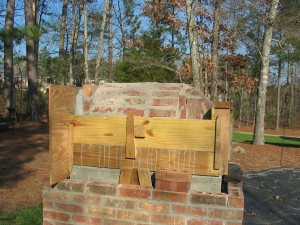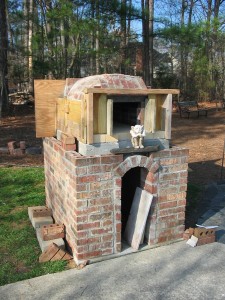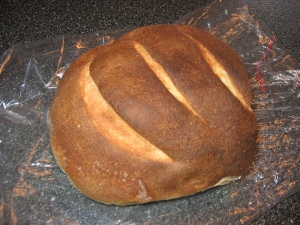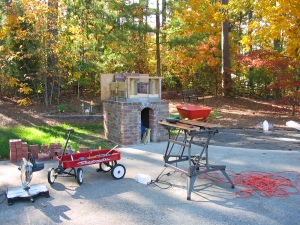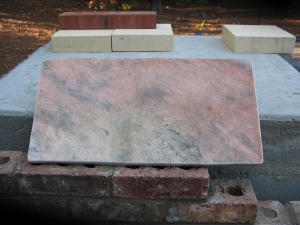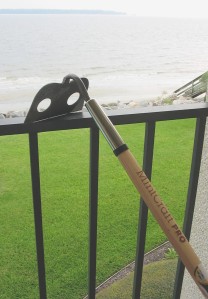I’m back from my trip to NC, and as the pictures below will testify I’ve made some real progress on my Georgia Brick Oven in the last two days. Oh, need to mention that during my road trip I stopped by the Lodge cast iron outlet store in Commerce, GA and bought a large cast iron dish (picture another time) to bake “whatever” in. The “Whatever” could be bread, a roast, a small turkey, two chickens etc. etc. And, it will fit through my oven door – something I can’t say for some of my other cookware.
First, I want to thank my Dad and sister Linda for giving me some fine hardwood fuel for the oven. When I got to the house in NC no one seemed to be home. Finally I noticed the sound of a chain saw, and when you can hear a chain saw in the middle of a 300 acre farm, it’s hopefully someone you know. Sure enough, there they were cutting up a black walnut tree that had fallen at the edge of a field. Linda cranks the chain saw and then hands it over to my 89 year old dad to do the cutting. AMAZING! As for the pecan wood, that had been cut previously and was stacked in the barn. It was in pieces that were too chunky for my oven, so they cranked up the log splitter to make kindling size pieces. That pecan wood is extremely tough, and when the splitter finally did its thing you wouldn’t believe the POW noise as the split pieces of wood went flying! I’m so glad I was standing far far away.
After I got home, the wood was stacked to dry out. I meant to cover it with a tarp but procrastinated. Therefore, it immediately rained all the next day. When I got started with the oven again, the first thing to do was continue with the side and back walls and cut bricks for and around the archway over the oven’s wood storage area. That went so well (using my recently purchased Black & Decker Storm Force hand-held cutter/grinder with diamond blade) that I decided to go ahead and mortar those bricks in place.
I had previously made an arch form out of foam core board with foam blocks glued between. I would normally have made the form from plywood and lumber, but I read a post where someone had used cardboard to make an arch form and I decided to give the slightly sturdier foam core a try. Just for the record, this lightweight and seemingly flimsy form worked extremely well. It was easy to cut out and was definitely rigid enough to support the six bricks in my arch. This form is the white half circle seen in the photo.
This is as far as the outer brickwork will go until the actual oven chamber is complete. Any higher and the walls would just get in my way as I’m placing the oven chamber brick.
Last thing I did today was mortar the hearth brick to the top of the hearth slab. The hearth brick turned out pretty well. Not as smooth and seamless as perfection but with that front arch in place the oven really starting to look like something! Click on the pics to embiggen.

Raincoat for the oven
I’ve covered the oven with a blue tarp to keep it dry from now on. Previously, if the brick got rained on, it was just a good way to keep them clean. However, now I want the core of the oven to start drying out.
Last comment is a thank you to two Mormon missionaries who helped me pick up brick from the side of the road. I had seen some abandoned brick from a demolished mail box post and went back today to scavange it before some other oven builder got them. They don’t match perfectly but will be OK to use for the back of the chimney or accent brick around the next arch which will be the oven door. I was loading them into the back of my truck when these two guys jumped out of their car (no, they weren’t on bikes) and asked if I had “lost my load”. At first I thought they might be cops come to arrest me for stealing bricks (ask my husband sometime about a previous bad day). However they were just nice young guys, helpful, interested in my project and even knew a place where I could get more free brick if needed. I took their phone info just in case and then we went our separate ways with the day made a little more interesting for all of us. They are a long way from home and I wish them well.

The Mormon Brick

Progress before NC trip
